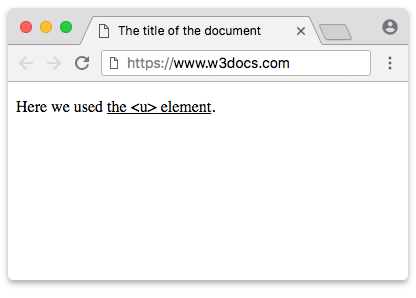In HTML 4.01, the <u> element was used to specify an underlined text. But the usage of HTML for stylistic effects isn’t a good practice anymore. Instead, it should be used for adding structure and semantic meaning.
In HTML5, the <u> element has a new, semantic meaning and specifies a text, which is stylistically different from a normal text, i.e., words or fragments of text that must be presented differently. These can be misspelled words or proper nouns in Chinese.
The <u> tag defines a span of text having an unarticulated but exactly rendered annotation. This means that the web developer and browser can choose how to show the annotation. Adding an annotation means adding a note or explanation. It must be non-textual. Browsers render a text surrounded by <u> tags as underlined, although it isn’t necessarily required.
The text in the <u> tag is being underlined (unless you style it otherwise).
In some cases, consider using other elements, such as:
- <em> for stress emphasis,
- <b> for drawing attention to a text,
- <cite> for book titles,
- <i> for technical terms,
- <mark> for highlighting phrases or key words,
- <strong> for specifying a text with strong importance.
If you want to add textual annotations, use the <ruby> tag.
Syntax
The <u> element comes in pairs. The content is written between the opening (<u>) and closing (</u>) elements.
Example of the HTML <u> tag:
<!DOCTYPE html>
<html>
<head>
<title>The title of the document</title>
</head>
<body>
<p>Here we used <u>the <u> element</u>.</p>
</body>
</html>Result

Example of the CSS text-decoration property:
<!DOCTYPE html>
<html>
<head>
<title>The title of the document.</title>
<style>
span {
text-decoration: underline;
}
</style>
</head>
<body>
<p>Here we used <span> CSS property text-decoration:underline</span>.</p>
</body>
</html>Attributes
The <u> tag supports the Global attributes and the Event Attributes.
How to style <u> tag?
Common properties to alter the visual weight/emphasis/size of text in <u> tag:
- CSS font-style property sets the style of the font. normal | italic | oblique | initial | inherit.
- CSS font-family property specifies a prioritized list of one or more font family names and/or generic family names for the selected element.
- CSS font-size property sets the size of the font.
- CSS font-weight property defines whether the font should be bold or thick.
- CSS text-transform property controls text case and capitalization.
- CSS text-decoration property specifies the decoration added to text, and is a shorthand property for text-decoration-line, text-decoration-color, text-decoration-style.
Coloring text in <u> tag:
- CSS color property describes the color of the text content and text decorations.
- CSS background-color property sets the background color of an element.
Text layout styles for <u> tag:
- CSS text-indent property specifies the indentation of the first line in a text block.
- CSS text-overflow property specifies how overflowed content that is not displayed should be signalled to the user.
- CSS white-space property specifies how white-space inside an element is handled.
- CSS word-break property specifies where the lines should be broken.
Other properties worth looking at for <u> tag:
- CSS text-shadow property adds shadow to text.
- CSS text-align-last property sets the alignment of the last line of the text.
- CSS line-height property specifies the height of a line.
- CSS letter-spacing property defines the spaces between letters/characters in a text.
- CSS word-spacing property sets the spacing between words.
Browser support
|
|
|
|
|
|
|---|---|---|---|---|
| ✓ | ✓ | ✓ | ✓ | ✓ |
Practice Your Knowledge
Quiz Time: Test Your Skills!
Ready to challenge what you've learned? Dive into our interactive quizzes for a deeper understanding and a fun way to reinforce your knowledge.